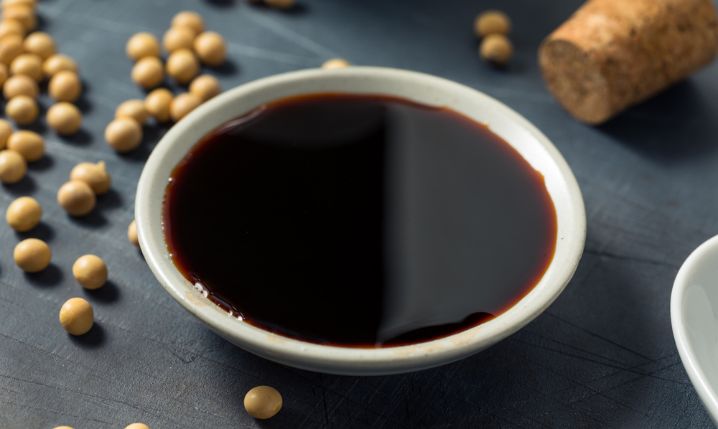Both liquid aminos and tamari are sauces that have a variety of uses. Used in cuisines around the globe, the differences can sometimes confusing. In this article, we compare liquid aminos vs. tamari so you can learn all you need to know.
Contents:
What Are Liquid Aminos?

Bragg’s Liquid Aminos is a popular sauce that is used as a condiment, marinade, dipping sauce, seasoning, and more.
Made from soybeans and purified water, liquid aminos are dark brown in appearance with a thin consistency that is similar to light soy sauce and coconut aminos.
Most often used to season vegetables or as a replacement for soy sauce, shoyu, and similar sauces in East Asian dishes, it has a savory, umami taste that greatly enhances the flavor of a dish.
Another good reason to use liquid aminos is that they’re gluten-free and MSG (Monosodium Glutamate) free, which makes them a popular alternative to many sauces that are not.
You can use liquid aminos as a seasoning sauce for vegetables and stir-fries. It can also be used as a dipping sauce for sushi, wontons, and similar foods. They are also used as a marinade for meat such as pork or chicken.
What Is Tamari?

Tamari is a popular Japanese sauce that is similar to shoyu and soy sauce. It has a thick consistency with a dark-rich brown color, like dark soy sauce.
It is made by pressing fermented soybean paste to extract all the liquid to create the sauce itself. This is what gives it the classic umami flavor, but unlike some soybean-based sauces, it can taste more nuanced with less saltiness.
One reason that tamari is experiencing growing popularity in the West is that it’s an excellent gluten-free, low-sodium alternative to soy sauce. If you can find organic brands of tamari, then they’re usually prepared in traditional means, which also means they are MSG-free.
You can use tamari as a seasoning sauce or even as a dipping sauce for sashimi, spring rolls, and similar foods. As with most seasoning sauces, you can use it to add flavor and color to stir-fries, noodles, rice, and vegetables.
What’s The Difference Between Liquid Aminos and Tamari?
| Liquid Aminos | Tamari |
|---|---|
| Created from soybeans and purified water. | Created from soybean paste. |
| Gluten-free, MSG-free, Vegan-friendly | Gluten-free, MSG-free (organic brands). |
| Savory, sweet, mildly salty flavors. | Rich, savory, nuanced flavors. |
| Thin consistency. | Thick consistency. |
The big differences between the two sauces come from flavor, appearance, and consistency.
Liquid aminos taste saltier than tamari, but they also have a more distinct sweetness that is preferable to some, and is also why they’re a popular seasoning sauce for vegetables. Tamari leans more toward having a rich, savory flavor that can work better with meat and noodle dishes like ramen.
The other factor is the consistency because liquid aminos have a thinner viscosity that is more like vinegar than tamari which is thicker and works better at coloring your dish and sticking to your food.
- Consistency Liquid aminos have a thin consistency, while tamari has a thick consistency because of having different water content ratios.
- Appearance: Both sauces have a deep brown appearance, but tamari is a little darker, making it look richer because of the consistency differences.
- Taste and flavor: Both liquid aminos and tamari have a famous umami taste, but the flavor differs as liquid aminos are sweeter and saltier overall.
- Culinary uses: You can use liquid aminos or tamari in most of the same dishes, such as fried rice, noodles, etc. However, liquid aminos work better with most green vegetables because of its sweetness. In contrast, tamari is a better option for coloring foods and giving them a ‘stickier’ texture which is one reason why it works better as a marinade for meat.
Conclusion
You can use these sauces as substitutions for one another in most scenarios as they both offer the umami flavor that’s important with either. They’re both gluten- and MSG-free, which is ideal if you have intolerances or allergies. However, when comparing liquid aminos vs. tamari, you should know about minor differences in flavor and consistency. Now you know about them, and you can keep them in mind!